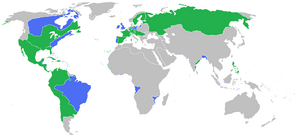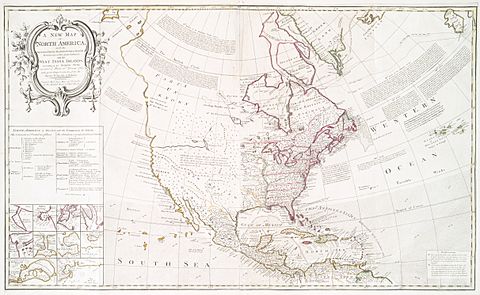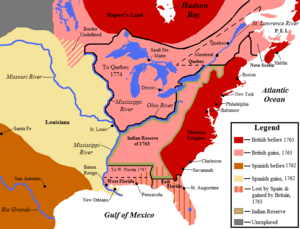Treaty of Paris (1763) facts for kids

The combatants of the Seven Years' War as shown before the outbreak of war in the mid-1750s.
Great Britain, Prussia, Portugal, with allies France, Spain, Austria, Russia, with allies |
|
| Context | End of the Seven Years' War (known as the French and Indian War in the United States) |
|---|---|
| Signed | 10 February 1763 |
| Location | |
| Negotiators |
|
| Signatories | |
| Parties | |
The Treaty of Paris, also called the Treaty of 1763, was a very important agreement. It was signed on February 10, 1763. The main countries involved were Great Britain, France, and Spain. Portugal also agreed to it.
This treaty officially ended the Seven Years' War. In North America, this war was known as the French and Indian War. The treaty marked the start of a time when Great Britain became very powerful outside of Europe. Great Britain and France gave back many lands they had captured during the war. However, Great Britain gained a lot of France's lands in North America. The treaty also said that Great Britain would protect Roman Catholicism in the New World.
Contents
What Lands Were Exchanged?
During the war, Great Britain took over many French colonies. These included Canada, Guadeloupe, Martinique, and other islands like Dominica and Grenada. They also captured French trading posts in India and a slave-trading station in Gorée, Africa. From Spain, Great Britain took Manila in the Philippines and Havana in Cuba.
France had captured Minorca from Britain and some British trading posts. Spain had taken a fortress in Portugal and a colony in South America.
In the treaty, most of these lands were given back to their original owners. But Britain got to keep many important areas. France and Spain returned all the lands they had conquered from Britain and Portugal. Britain gave back Manila and Havana to Spain. It also returned Guadeloupe, Martinique, Gorée, and the Indian trading posts to France.
In return, France agreed that Britain now owned Canada. France also gave up Dominica, Grenada, and other islands to Britain. France also gave the eastern part of French Louisiana to Britain. This area stretched from the Mississippi River to the Appalachian Mountains. Spain gave East Florida to Britain. France got its trading posts in India back. But they agreed not to send troops to Bengal and recognized British allies as rulers in key Indian states. Britain agreed to remove its forts in British Honduras (now Belize) but could still cut logwood there. Britain also confirmed that its new subjects could practice Catholicism.
France lost almost all its land in mainland North America. The only part left was the western half of Louisiana. France kept fishing rights off Newfoundland and two small islands, Saint Pierre and Miquelon. These islands were important for drying fish. France also got back its valuable sugar colony, Guadeloupe. Many French people thought Guadeloupe was more important than Canada.
The Louisiana Question
The Treaty of Paris is often seen as France giving Louisiana to Spain. However, this transfer actually happened earlier. It was a secret agreement in the Treaty of Fontainebleau (1762). This secret deal was not announced until 1764. The Treaty of Paris gave Britain the land east of the Mississippi River. This included Baton Rouge, Louisiana. New Orleans, which was also on the east side, stayed with France for a short time. The Mississippi River area in Louisiana was later reunited. This happened after the Louisiana Purchase in 1803.
Why Canada Was Important
Britain's View
The war was fought around the world. But Britain started the war mainly because of French lands in North America. There was a big debate in Britain. Should they keep Guadeloupe, which made a lot of money from sugar? Or should they keep Canada, which was expensive to manage? Britain decided to keep Canada for strategic reasons. They returned Guadeloupe to France. France was weaker after the war but was still a powerful European country. The British Prime Minister, Lord Bute, wanted a peace that would not make France want to start another war soon.
The British were mostly Protestant. They worried about having so many Roman Catholic subjects in Canada. But Britain did not want to make France angry by forcing people to leave or change their religion. They also did not want French settlers to leave Canada and make other French settlements stronger.
France's View
Unlike Lord Bute, the French Foreign Minister, the Duke of Choiseul, expected another war later. But France needed peace to rebuild its strength. France preferred to keep its Caribbean islands because of their profitable sugar trade. The large Canadian lands had been a financial burden for France. French diplomats believed that without France to control them, the American colonists might try to revolt. France also wanted to allow people, like nobles, to leave Canada if they did not want to promise loyalty to the British King. Finally, France wanted protection for Roman Catholics in North America.
The Dunkirk Question
During the peace talks, a big disagreement was about the forts in the French town of Dunkirk. The British had long worried that Dunkirk could be used by France to launch an invasion of Britain. In an earlier treaty from 1713, Britain had forced France to limit these forts. The 1748 Treaty of Aix-la-Chapelle allowed France to build more defenses.
The 1763 treaty made Britain force France to go back to the 1713 rules. France had to tear down the forts built since then. This made France very angry. This anger lasted for a long time. Eventually, this rule was changed in the 1783 Treaty of Paris, which ended the American Revolutionary War.
How People Reacted
When Lord Bute became the British Prime Minister in 1762, he wanted to end the war quickly. He worried that Great Britain could not control all the new lands it had gained. So, in the peace talks, Bute gave some colonies back to Spain and France.
Even though Bute wanted peace, many in the British Parliament did not want to give back any lands won in the war. A famous opponent was former Prime Minister William Pitt, the Elder. He warned that the treaty would lead to more wars once France and Spain rebuilt their power. He said the peace was "insecure" and "inadequate." However, the treaty was approved by a large vote of 319 to 65.
The Treaty of Paris did not consider Great Britain's ally, Frederick II of Prussia. He had to make his own peace deal five days later in the Treaty of Hubertusburg. For many years after, Frederick II said Britain had betrayed him.
American colonists were unhappy that the treaty protected Roman Catholicism. This was because most colonists were strong Protestants. Some historians believe this was one reason for the growing problems between America and Britain. These problems later led to the American Revolution.
Effects on French Canada
The treaty allowed people to leave Canada freely for 18 months. But it was expensive to travel on British ships. About 1,600 people left New France under this rule. However, only 270 of them were French Canadians. Some people think this was part of a British plan to limit how many people left.
Article IV of the treaty said that Roman Catholicism could be practiced in Canada. King George III agreed to allow Catholicism as long as it followed British laws. At that time, British laws had rules to stop Roman Catholics from holding government jobs. This was because Catholics were sometimes seen as supporters of those who wanted to take the throne. These rules were relaxed a bit in Quebec. But top jobs, like governors, were still held by Anglicans.
Article IV is also why Quebec often has its own unique laws. These laws are different from the rest of Canada. There was a general rule in the United Kingdom that conquered colonies could keep their own laws. However, the king could still change these laws. But the treaty removed this power. This is because treaty terms were considered very important. In Quebec, Roman Catholics could be jurors in lower courts and use French law. But the judge was British, and his view of French law might be limited. If a case went to a higher court, French law and Catholic jurors were not allowed.
Many French people from what are now Canada's Maritime Provinces, called Acadians, were forced to leave their homes between 1755 and 1763. After the peace treaty guaranteed some rights to Roman Catholics, some Acadians returned to Canada. But they were not welcome in English Nova Scotia. They were forced to move to New Brunswick. This is why New Brunswick is a bilingual province today.
Much land that France once owned was now British. The French people of Quebec felt very betrayed by France giving up their land. The British Commander-in-Chief, Jeffrey Amherst, noted that many Canadians thought their colony was very important to France. They could not believe that their country had been given to Great Britain.
Images for kids
See also
 In Spanish: Tratado de París (1763) para niños
In Spanish: Tratado de París (1763) para niños




